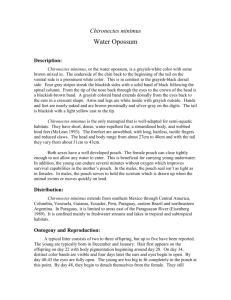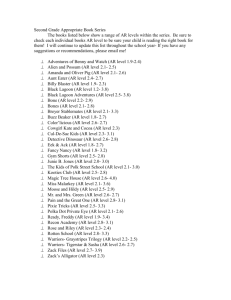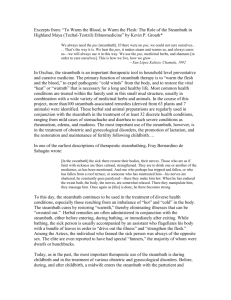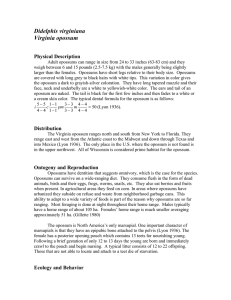Document 11853525
advertisement
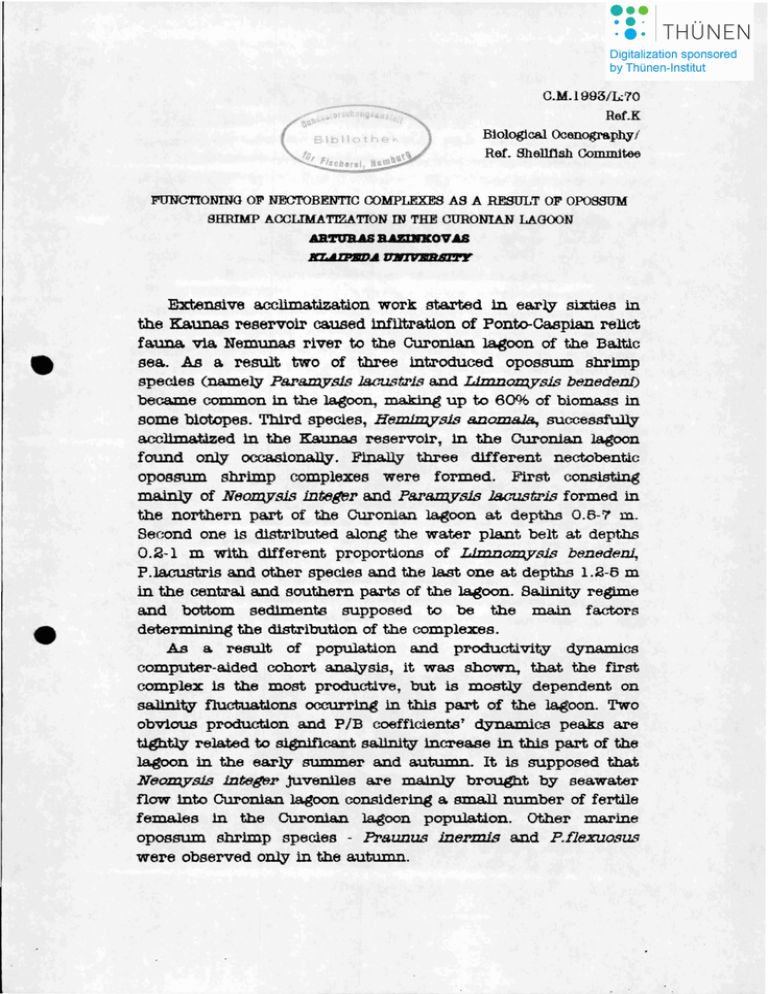
C.M.19931L:70 Ref.K B1ologlcal ÜC6Il<>grapbyI Rat. Shellf1sh CoIllIIlit.ee FUNCTIONING OF NECTOBENTlC COMPI.EXEB AB A RESULT OF OPOSSUM SHRIMP ACCLIMATlZATION IN THE CURONIAN LAGOON a~B·ZIW'I[OV.A8 Ext8ns1ve acclimatization work Bta.rt6d 1n early sixties in the K.a.una.s reservoir C8.uaed 1nflltrat1on of Ponto-Ca.spian reUet fauna. via. Nemuna.s river to the Curon1an lagoon of the Ba.lt1c sea. Aß a result two of three 1ntroduced opossum shrlmp spec1es (namely PBJ.'"a.m.ysll: Jacu..qt1'is and l,fmnomysis beD.edeDi) beca.me common in the lagoon, making up to 60% of biomass in some biotopes. Tb1rd spedes, H8m1J:rJ.Yf1Lq a.IJomaJa, successfully accl1ma.t1zed 10 the KaUDaB reservoir, 10 the Curonian lagoon found only occa.s1onaJ.ly. FinaJ.ly tbree different nectobentic opossum shrimp complexes were formed. First consiBting maiDly of N8amysis int8ge1' and P8.1'am;ysis l&cu..qt;pis formed in the northern part of the Curonian la.goon at depths 0.6-7 m. Second one ls diBtr1buted a.long the water plant halt at depths 0.2-1 m with different proportions of l,fmnom.ysi..q beD.8d8Ili, P .la.custris a.nd other spec1es and the la.st one at depths 1.2-6 m in the centra.l a.nd southern parts of the la.goon. Salinity regime and bottom sediments supposed to be the main factors det6rm inin g the distribution of the complexes. AB a result of population and productivity dynamics computer-aided cohort a.naJysls, it was shown, tbat the first complex 18 the most product1ve, but is moatly dependent on saJ1n1tQ fluctua.tions occurrlng in this part of the lagoon. Two obvlous product1on and P IB coefflc1ents' dynamics peaks are tlgtltly related to slgrlificant sa.l1nity 1ocrea.ae 1n thiB part of the la.goon in the early summer and autumn. It 18 supposed that NeomysJs lnt8lf81' juveniles are maJnly brough.t by seawater flow 1000 Curon1a.n lagoon conslderlng a small number of fertile females in the Curon1a.n lagoon population. Other marine opossum shrimp species - Praunu..q Jne1'1D.is a.nd P.f1exuosu..q were observed only in the autumn. The second complex is strictJy rela.ted to water vegetation, where the L. beneden1, the dominant species of tbis complex is mostly abundant. Production dyna.mics of tbis complex a.re subjected to drastic cha.nges during the summer due to the vegetation decllne in the period of blue-green aJga.e bloom, while the P/B coefflc1enta show constant increase. The third complex is dominating over the maJor part of the Curonlan lagoon and consl8t1ng mainly of pure P.l&custris population. It's production and P/B coefflcient shows three obvious BUccedent pealts during the summer, ea.ch responding to a new generation of opossum shrimps. ~__ the observed species ha.ve different feeding patterns. The ost abundant spec1es P .lacustrls is typicaJly detritofagous during da.yllght hours, while others vary in their feecUng preferences. 81gn1fica.nt amounta of blue-green aJga.e were found in the stomachs of another a.cclimatized opossum shrimp - L.benedenl. Accljmatized opossum shrimps a.re supposed to shorten food webs of commercial predator fish species from fish->fish->zoopla.nkton/benthos to fish->opossum shrimp. 8igniflca.nt amounta of opossum shrimps were found in predatorous fish juveniles stoma.chs in the stage when they a.re natura.lly turnlng to predatorous feeding. Opossum shrimps were also found in the stoma.chs of such bentofagous flsh as bream and planctJ.vorous ones (they feed on mysids during night vertica.l migrations). Planktivoröus flsh feeding on mysids ca.n be considered aB 11 energy and matter elevator II from benthic f ood chain with the detritus overproductJ.on to the pela.gic one. Overall population and productivity dynamics are in a good agreement with seaaonaJ production and destructJ.on processes in the lagoon. Correla.tion analysis between prodUctJ.on of the nectobentic complexes and the productJ.on in the varlous food chains (incDuUng chroloflll and pr1ma.ry productJ.on dynamics) showed significa.nt correlation coeffic1ente. It is despite the natural three-modal l1fe cycle of the most abundant opossum shrimp species, P.la.custris, while the productJ.on and destructJ.on processes in the la.goon ha.va claar bimodaJ cha.ra.cter. It is tha reason to state that natural l1fe cycles of tha a.cclimatized opossum shrimp were quan.titativly modifiad througb. blocanothlc adaptation mechan1BID.B.

